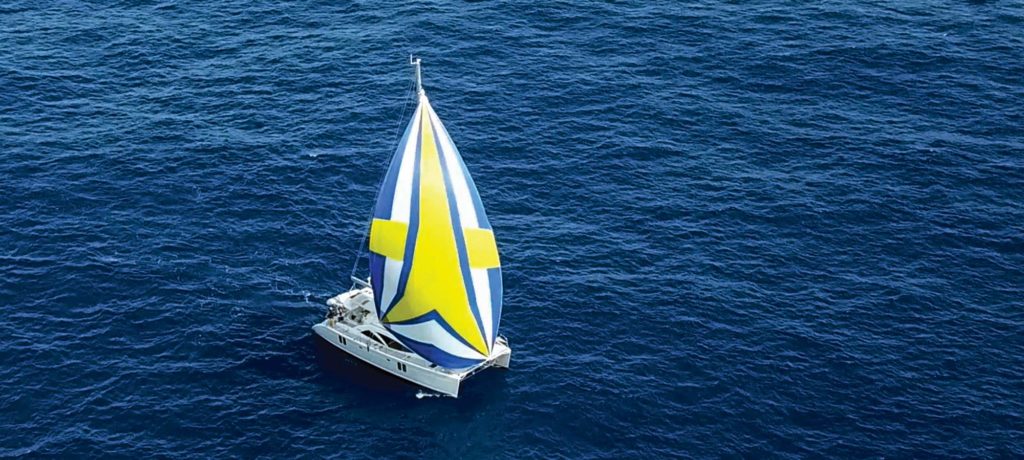
Monohull or multihull? Have you ever gone back and forth pondering the pros and cons of cruising on each? We certainly have, so when my husband, Paul, and I were given the chance to deliver a brand-new Bluewater 50 catamaran across the Atlantic from Las Palmas, Gran Canaria, in the Canary Islands to St. Lucia in the Caribbean last winter, we jumped at the chance. Paul and I have been cruising and living aboard since 1989 and have sailed more than 100,000 nautical miles on the four boats we’ve owned over our nearly three decades of global voyage-making. The boats were all monohulls, but every time we bought a new one, we toyed with the idea of moving to a catamaran. Why? We discovered that we enjoy shallow-draft sailing, which most multihulls offer, as much as we love offshore passagemaking. For long-term living aboard, the space offered aboard most multihulls is certainly attractive. We were proud of our first boat, Two-Step, a Sparkman & Stephens design called the Classic 37, but after a while, we found her depth restrictive as we discovered how much we enjoyed gunkholing and navigating through small inland waterways. Cruising had become a lifestyle for us, and we wanted more space on board plus a few more comforts. Paul and I feel blessed since, as independent television producers and travel-documentary filmmakers, we are able to earn our living while sailing full time, but all the camera, audio and editing equipment we need to carry takes up a lot of storage space. We needed to expand.
The criteria for our next boat was a good shallow-draft design with safe and comfortable offshore capabilities, so multihulls were definitely under consideration. In the end, we stuck with what we knew and ended up choosing a monohull with a swing keel, a configuration that has suited us on our cruising journeys for many years.
Although we are now in the process of building our new boat, a Southerly 480, we continue to be intrigued by catamarans. Feeling out of sorts being “between boats,” we chartered a Voyage 50 catamaran in the British Virgin Islands to get a much-needed sailing fix in the tropics, and spent the time with friends aboard. It was a luxurious boat, with four en-suite cabins with queen berths, and was set up well for chartering, but we wondered what a catamaran this size would be like for serious ocean cruising. We were soon to find out.
Discovery Yachts builds several brands of high-quality cruising yachts, including Southerlys and Bluewater catamarans, and the company reached out to us with an opportunity to deliver a new Bluewater 50 called Zão (pronounced zay-oh by the owners) from the Canary Islands to the Caribbean, leaving Gran Canaria in early November. Zão‘s owners, John and Caroline Charnley, highly experienced sailors and the newly retired former owners of Discovery Yachts, had family and business commitments until Christmas but wanted the boat moved to the Caribbean so they could enjoy a winter of island-hopping before going through the Panama Canal. They asked us if we would take the boat across to St. Lucia for them. Seeing this as a great chance to sail a purpose-built 50-foot offshore cruising catamaran to learn how it performed on an ocean passage in the many conditions we were sure to encounter on a 2,800-nautical-mile Atlantic crossing, we accepted the offer.
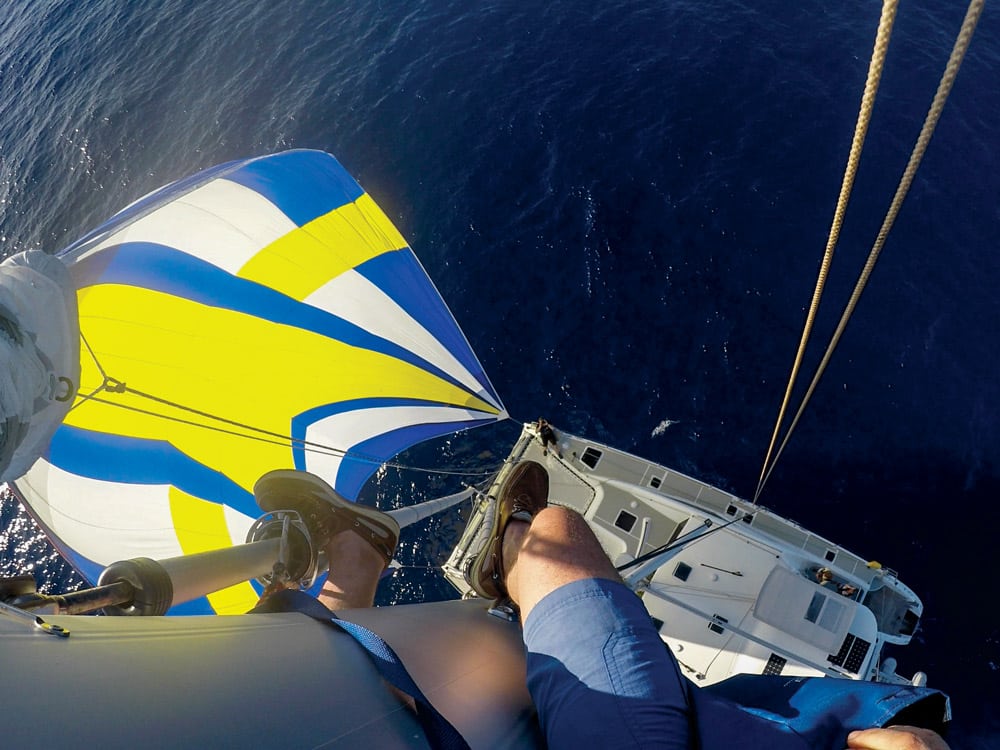
We flew to the Canary Islands the first week of November 2017 to meet up with John and his new Bluewater 50 in Las Palmas. Soon to join us would be four friends as crew, all fellow sailing bloggers and videographers — Alexandra Palcic and David MacDonald of Sailing Banyan; Dan Krughoff, professional chef and videographer; and sailing vlogger and police officer Craig Bowman, of Cruising Off Duty. All were monohull sailors with some catamaran experience, mostly through chartering. Dave and Alexandra lived aboard their boat in the Caribbean, having sailed from Canada several years ago. Dan and Craig were each in the market for a catamaran for full-time voyaging.
November is a popular time to make the east-to-west crossing of the Atlantic Ocean because hurricane season is officially over and you arrive in the Caribbean in time for Christmas, a nice time to start a winter of exploring the islands. More than 200 boats participating in the Atlantic Rally for Cruisers were descending on the marina in Las Palmas to begin preparations for their ocean run to St. Lucia, as were many other independent non-ARC cruising boats and crews, so it was a crazy, busy, festive place at that time of the year. Las Palmas has one of the best marinas in the Canary Islands for sailors since every supplier and service needed for yachts preparing for an ocean crossing can be found there.
Seeing Zão at the dock when we arrived in Las Palmas was such a delight. Her long, swooping modern lines were a contrast to the more angular-shaped catamarans gathering in the marina. What a difference from the 50-foot cat we had chartered earlier, which, in fairness, was set up purely for vacationing. Zão was designed for long-term living aboard and long-haul passagemaking. This was the second Bluewater catamaran the Charnleys had built, so they had thought through every detail for comfortable living in their retirement but also set the boat up for serious adventure on their upcoming around-the-world voyage.
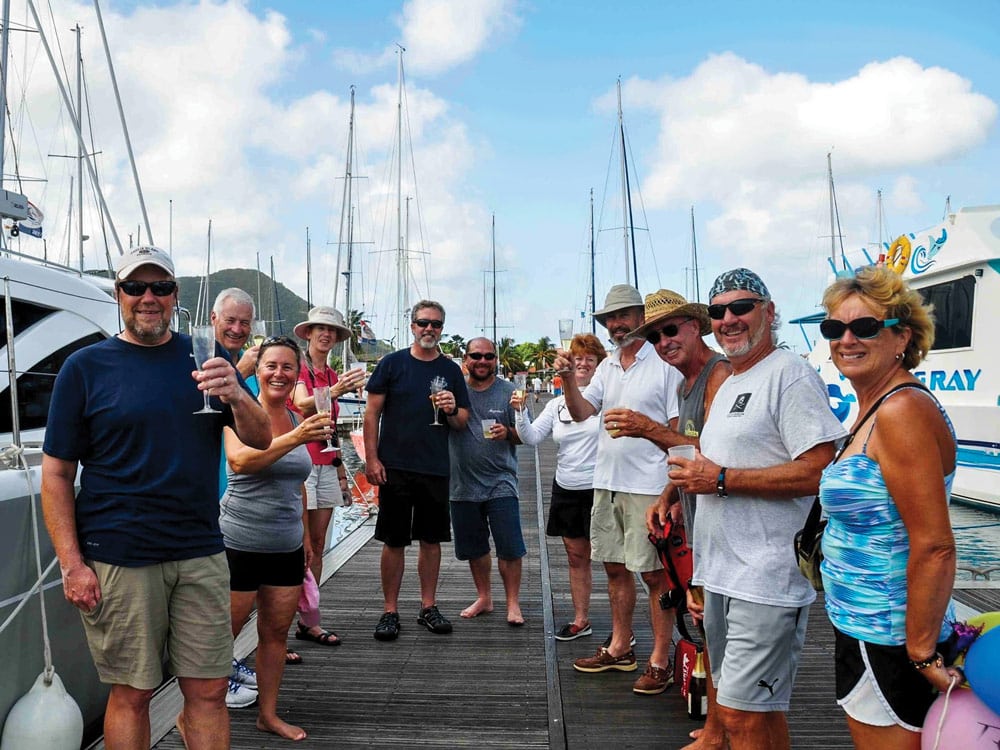
When Paul and I stepped on board, the first things we noticed were the fine table lamps and two free-standing lounge chairs in the main saloon, neither of which appeared to be bolted down. As monohull sailors, this made us nervous.
I asked John about how these were to be stowed offshore. He just smiled.
“You’re on a catamaran now. They will just sit here for the whole passage. You don’t have to stow things the way you do on a monohull,” he assured me. “You can even move the chairs around to watch the large-screen TV.” He continued to grin. This was going to be a very different passage compared to what we’re used to.
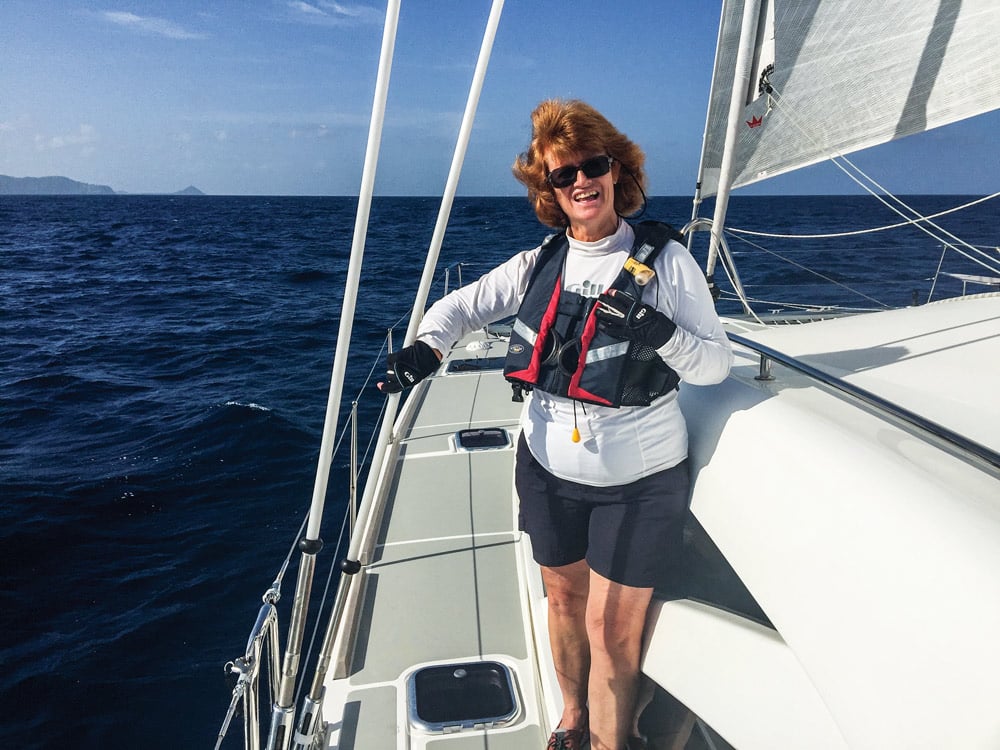
Paul and I had gotten somewhat comfortable with leaving things sitting on tables and countertops while sailing on the catamarans we had chartered in the past, but in the British Virgin Islands we were sailing in the comfortable confines of the protected Sir Francis Drake Channel, not on the open sea. John showed me how the chairs were positioned on the floor with mere strips of Velcro and how the heavy table lamps sitting around the main saloon and navigation station were sitting on nonskid mats. I still wasn’t convinced that once we got some serious waves at sea these things wouldn’t go flying.
The next thing I noticed, as one who loves to cook, was the expansive galley on the bridgedeck, with an all-around view and opening windows into the cockpit. There were large, easy-to-clean Corian countertops, including a peninsula countertop that you could work at from three sides. There would be six of us aboard, and although Alexandra, Dan and I would be sharing most of the meal preparations, everyone liked to cook and would be pitching in, so it was nice to see that there was space for all of us to work.
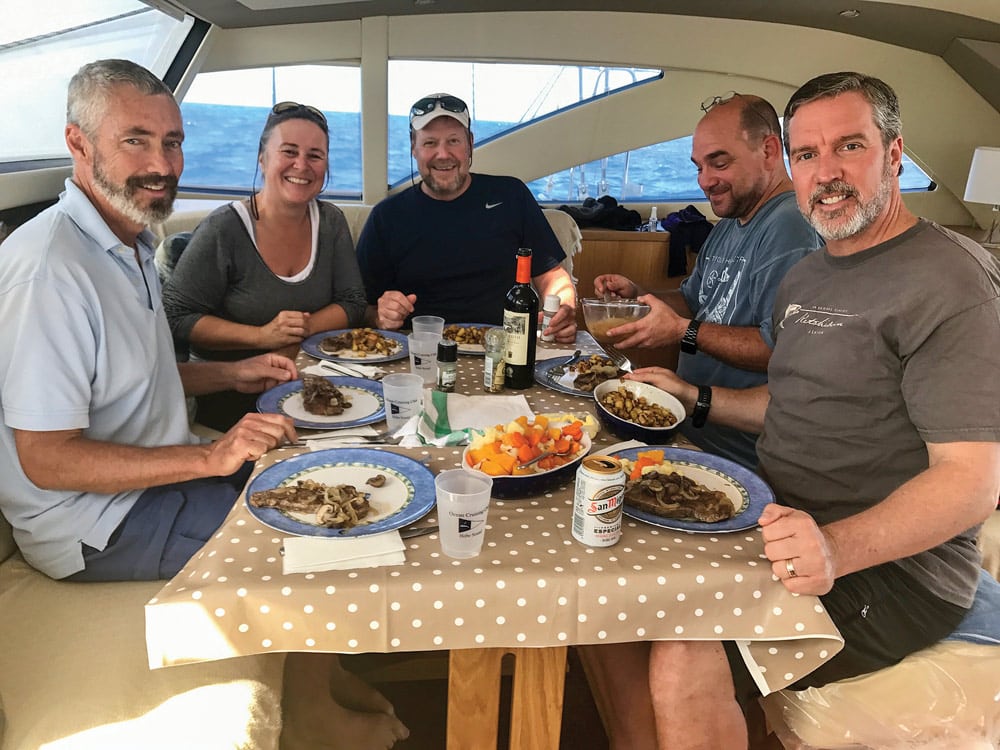
To add to our culinary creativity, there were a four-burner propane stove and oven, a microwave and a large front-opening fridge with two additional fridge/freezers in the owners hull to port. These had exterior temperature monitors and alarms. There were also numerous cupboards for storing supplies, so stowing our provisions was going to be a breeze!
Then Paul noticed a high-powered electric kettle.
“The electric kettle is just for port, right?” asked Paul.
“No, you can plug in this kettle anytime, even at sea,” John told us. “It’s the only one we’ve got or use.”
Paul looked skeptical, thinking of the power drain. Then John explained the electrical system — a hard Bimini the width of the cockpit, covered with solar panels; a 6 kW generator; and a large lithium battery bank. Right. The kettle wasn’t going to be a problem.
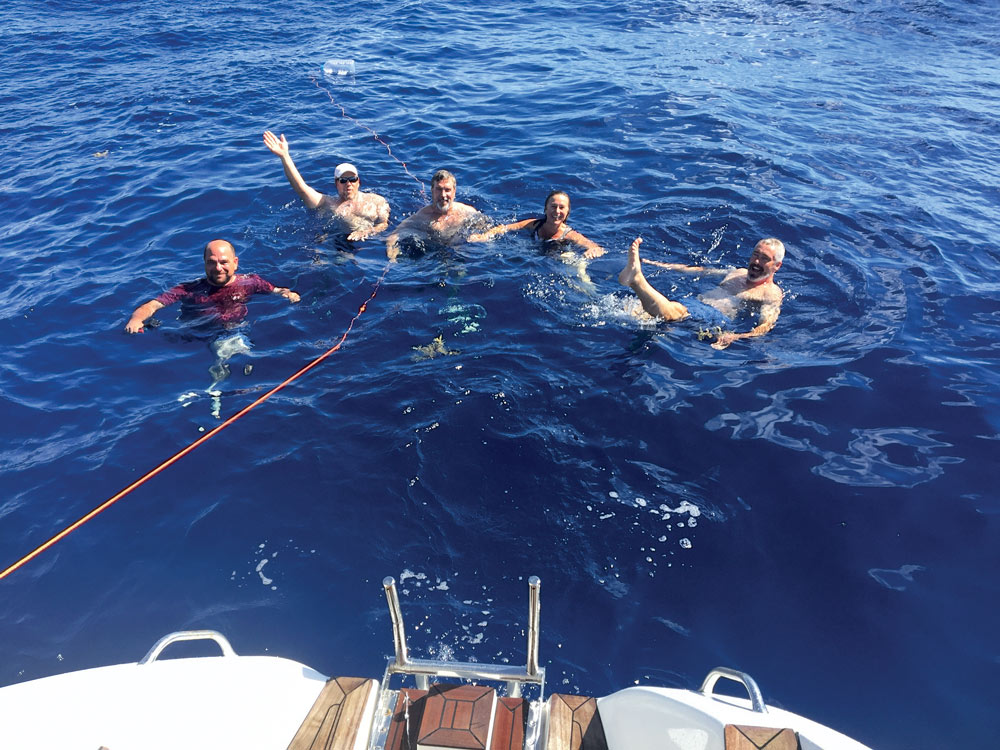
Paul and I made our home in the owners cabin, which featured a queen bunk aft and a head with separate shower and front-loading washer/dryer at the forward end. There were two other en-suite cabins on the starboard side. Dave and Alexandra took the queen berth aft. The forward cabin had a V-insert in the berth, which was removed to make twin bunks for Dan and Craig.
As soon as the crew was settled in, Alexandra and I began the mammoth job of provisioning for a crew of six people with help from Dan and Craig. Dave and Paul went over the boat’s systems with John, organizing repairs, doing maintenance and ensuring that everything was in good working order and that we understood the equipment before leaving for sea. Dan set up and tested our Iridium Go/PredictWind satellite and weather-routing system, and became our communications officer. Everyone pitched in whenever and wherever help was needed.
Alexandra is an impressive organizer and rearranged the contents of all the lockers for ease of access while we were underway, taking notes so we could return things to where John and Caroline had put them. She grouped all like items together, and put things close to where they would be used and where it would make the most efficient use of storage space. Then we started stowing bags and boxes, bottles and cans, long-life cartons of juices and milk, baskets of fresh produce, freezers full of frozen meat and shellfish, pizzas, berries and desserts. Since everyone on board was a foodie, this was not going to be a beans-on-toast cruise across the Atlantic!
This was our eighth transatlantic passage, and it turned out to be the lightest-wind Atlantic crossing we have ever made, with several days of total calm. Where were the trade winds?
Because we’re monohullers who don’t worry too much about weight on a boat, Zão was a bit heavy when we set sail from Las Palmas on November 12. An advantage, though, of a large cruising catamaran is that the boat can handle it, and as we were about to find out, we would be at sea for a lot longer than the two weeks we had planned on.
Fortunately, water usage wasn’t a concern either. Dave ran the generator twice a day during his and Alexandra’s 0800-to-1200 and 2000-to-2400 watch, and made plenty of water with the Dessalator watermaker at the same time. All six of us could have had two showers a day if we’d wanted to — and often did.
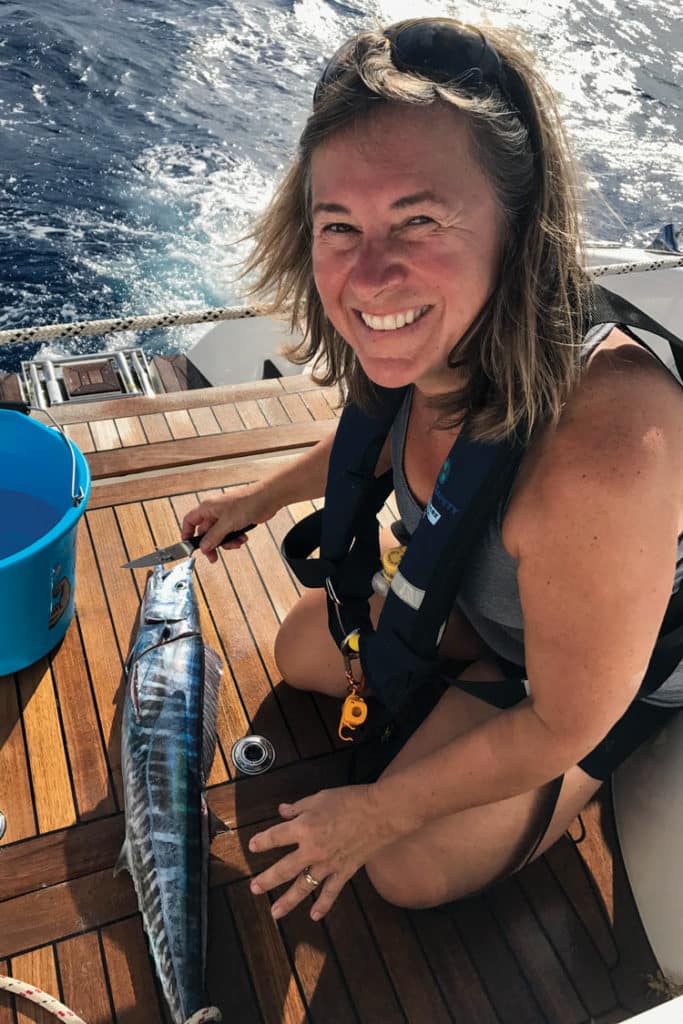
We had light but good breezes the first day out, which helped everyone get their sea legs and allowed us all to get used to the equipment on board and practice handling Zão‘s sails. The boat has Elvstrøm Epex laminated sails, which hold their shape and work well with the Seldén in-mast furling system. It took us a few tries to get the hang of the furler, so we appreciated Craig’s instruction on how to use it. He has it on his boat. The trick is to maintain tension on the mainsail at all times while furling it. We came to love it and, as a result, we ordered the same for our new boat.
One of the things we didn’t like about the other catamarans we had sailed was the noise of the waves slapping the bridgedeck, which was loud and never rhythmic. It got on our nerves, so Paul and I were rather anxious about how we would handle this on a long passage. However, on the Bluewater 50, the hull shape was designed to counter this, and we found that startling wave slaps happened less often and weren’t as loud or bone-shaking when they occurred. Granted, we never got the big seas we had been hoping for to test out the boat.
This was our eighth transatlantic passage, and it turned out to be the lightest-wind Atlantic crossing we have ever made, with several days of total calm. Where were the trade winds? Like all the other boats around us (we were receiving position reports from the ARC and ARC+ fleets), we all ended up being at sea for at least an extra week longer than planned.
We checked the weather using PredictWind a couple of times a day, and there was nothing but days of extremely light wind or no wind at all in the forecasts. The Bluewater 50 is a fast cat and, thank goodness, handled the light airs well, but we never got the conditions to really put her through her paces.
We started by sailing wing-and-wing using two headsails but ended up flying the asymmetric spinnaker day and night, doing two-person watches around the clock just to keep the boat moving. We all got pretty good at sail trim. When the wind dropped, we doused the sail and, mid-Atlantic, had a swim 1,000 miles away from the closest land. We fished. We cooked. We ate. We slept. We celebrated Thanksgiving. Alexandra baked cakes. We read. We danced. There was lots of room. We chased birds off the deck, which must have mistook us for an island. We shouted with delight when dolphins came to play. Craig flew his drone. We saw amazing sunsets and shooting stars. We played cards, which included a three-week Wizard tournament. We watched TV. Had pizza-and-a-movie nights. We left our cameras and computers lying around. Were we on a boat? It was way too comfortable.
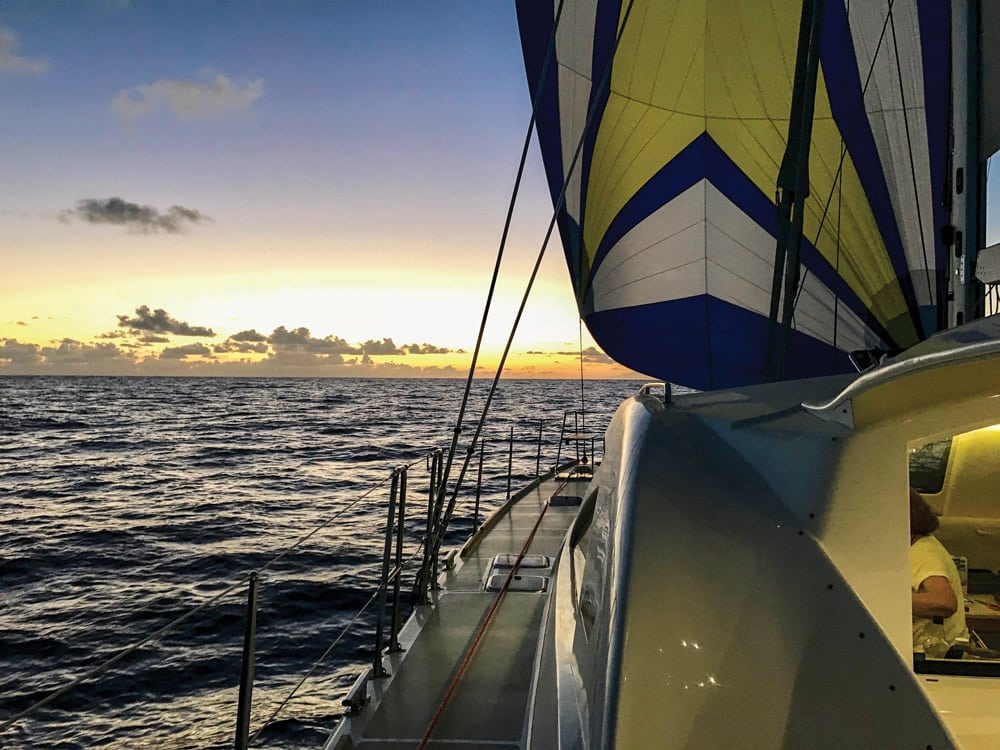
One thing I noticed about passagemaking on a multihull is that I had much more energy than when I go to sea on a monohull. Not being on a heel all the time means it doesn’t take as much physical effort to do simple tasks. Overall, everyone in the crew felt the same. We also dealt with tasks more readily since it didn’t take much effort to get up and deal with things.
Unfortunately, or fortunately, this applied to cooking. We were constantly preparing meals and feasting. No one lost weight as we usually do on a monohull passage, where you sometimes eat minimally since food prep and eating just feel like too much effort at times.
On December 3, 21 days and 3,000 nautical miles after setting sail from Las Palmas, Gran Canaria, we made landfall in St. Lucia. The boat felt enormous as we came into Rodney Bay Marina, but with the twin Yanmar 80 hp diesel engines, we could turn on a dime. Twin screws make even large multihulls easy to maneuver. We were greeted by the happy owners, John and Caroline.
So, have we become multihull converts? Well, we can definitely see the advantages now and understand why for some sailors they are a good choice for cruising. It all comes down to what works for each of us. After all, it’s love for being on the water that all cruising sailors share — be it on one hull or two.
Sheryl and Paul Shard have been living the cruising dream for nearly 30 years. Together they have traveled more than 100,000 miles under sail, including eight Atlantic crossings. Learn more about the Shards’ adventures and their TV series, Distant Shores, on their website.








